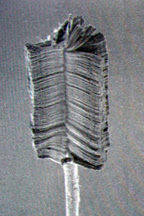Teeny, tiny brush
UH researchers enter the record books with a nanotechnology coup
Development of "the world's smallest brush," with bristles more than 1,000 times finer than a human hair, has earned University of Hawaii scientists and mainland colleagues a spot in the 2007 Guinness Book of World Records.
 COURTESY IMAGE
Bristles on this brush are 1,000 times finer than a human hair.
|
|
The invention of the smallest nanotube brushes is part of a larger project of the Hawaii Nanotechnology Laboratory, which could help put Hawaii on the map in the burgeoning nanotechnology field, officials at the school believe.
"The micro/nano revolution has the potential ability to touch every aspect of modern life in the next 50 years," said Mehrdad Ghasemi-Nejhad, who founded the UH-Manoa lab in 2003.
He said it is the first of its kind involved in analysis, fabrication and testing of nanodevices and nanocomposites.
The lab's nanobrush can be used in many applications, such as sweeping up nano dust, painting small size micro-tubes and cleaning up pollutants in water, Ghasemi-Nejhad said.
The microscopic brushes also can be used on a larger scale to conduct electricity in electric motors, he said.
"The secret is in carbon nanotubes, tiny strawlike molecules just 30-billionths of a meter across. They are incredibly tough and yet flexible enough that they will yield when pushed from the side."
The researchers created the bristles from hot, carbon-laden gas onto threads of silicon carbide finer than a baby's hair after recognizing a different kind of material was needed to work in the nanoscale, Ghasemi-Nejhad said. "Nano" refers to objects measured in billionths of a meter.
Ghasemi-Nejhad's group worked on the nanobrush with Pulickel Ajayan and his team at the Rensselaer Polytechnic Institute in Troy, N.Y.
Describing broad applications of nanotechnology, Ghasemi-Nejhad said, "For example, now we can make properties much tougher and stronger at little cost that would enhance materials performance in the surfboard industry or boat industry.
"Also, it will open opportunities in nanoelectronics," he said, explaining "the size of connection wires in electronic computer chips has reached its limit in top-down manufacturing."
Nanotechnology uses a bottom-up approach, starting with atoms and molecules and putting them together to develop desired structures, such as a nanowire for electronics, he said.
Thinking small
The University of Hawaii-Manoa Nanotechnology Lab will host an international nanotechnology conference Sept. 20-22 at the East-West Center.
The "Multifunctional NANOcomposites International Conference" is being held here for the first time by the American Society of Chemical Engineers.
Sir Harold (Harry) Kroto, co-recipient of the 1996 Nobel Prize in Chemistry, will be a keynote speaker. Other lectures, paper presentations and business ideas will be featured.
The conference also is focusing on nanotechnology commercialization, providing startup companies an opportunity to meet with national and local venture capitalists and investors.
|
Using nanotechnology, he said, smaller and smaller chips can be made to reduce the size and weight of computers while increasing their speed and memory "much beyond the current state of art."
Other nanotechnology applications include precision laser communications for space applications, nanocoating to prevent corrosion, and low-cost, better-performing fuel cells that use hydrogen as clean fuel instead of fossil fuels in automobiles, he said.
Others from UH-Manoa who worked on the brush project were Anyuan Cao, associate director of the Nanotechnology Laboratory, and doctoral student Vinod P. Veedu.
"We need to look at the needs in the nano-world, where machines and materials can be the size of atoms and molecules," Veedu said. "As in the 'bigger' world, there are messes to sweep, walls to paint, tubes to unclog and electronics to power. So our invention ... demonstrates a way to make the tiniest of brushes to do these jobs."
Ghasemi-Nejhad said he founded the nanotech lab in the Department of Mechanical Engineering "to develop nanomaterials, nanostructures, nanodevices and smart structures with nanopositioning capability."
Smart structures, he explained, have integrated sensors, a control system and actuators that function similar to a human body with a sensing system, brain and muscular system.
The National Science Foundation estimates there will be $1 trillion a year of products based on nanotechnology by 2015 requiring 2 million workers, he said, adding that one of his lab's goals is to train students for that development.

